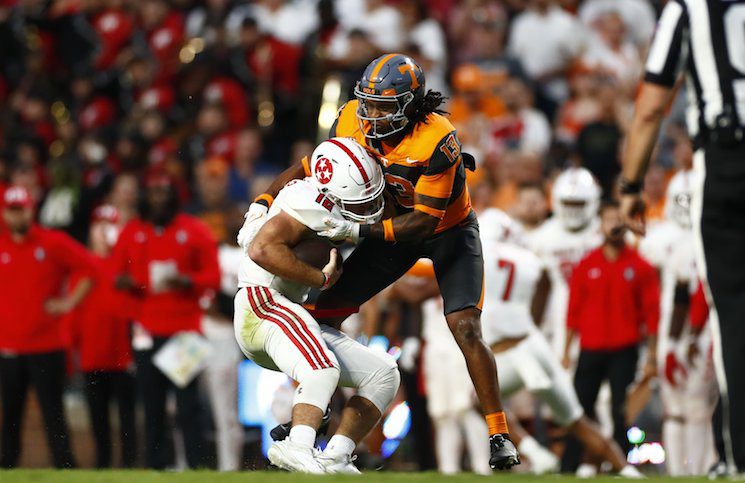
This Week in UT Sports History is a weekly series written by RTI columnist Lexie Little
Tennessee will face five of the Top 15 teams in the country in 2020 should football season come to fruition. With the addition of non-divisional opponents No. 13 Texas A&M and No. 11 Auburn to the slate, the Vols find themselves battling both a global pandemic and a formidable schedule.
Southeastern Conference officials announced new COVID-19 management requirements for athletics, including directives for testing and mask use, on Aug. 7. Football players and those in direct contact with the sport will receive a surveillance test at least twice per week during competition.
Volleyball and soccer likewise will receive two surveillance tests weekly, while cross country student-athletes will receive one. Tests will likely be administered at six days and at three days before competition. All coaches and staff on the sidelines of football, soccer and volleyball games must wear face coverings and physically distance. Cross country athletes will wear face coverings at the starting line and remove them once runners meet distancing requirements.
In 1918, health officials in Lexington, Missouri, encouraged gauze mask use, even for players, as the Spanish Influenza remained prevalent. Each player on the Wentworth Military Academy and St. John’s Military School football teams wore masks during play. On Oct. 10, 1918, the St. Louis Post-Dispatch reported Washington University football players wore their “influenza masks of gauze” at all times while on campus except during practice. And on the same day in Knoxville, a Journal and Tribune headline caught attention: “1,045 ‘Flu’ Cases in Knoxville; Public Places Close Indefinitely…U. of T. Quarantined…”
Masks, of course, were encouraged.
While the University of Tennessee welcomes masked students back to campus this week, Rocky Top Insider takes a look back at other happenings this week in UT sports history:
Aug. 16, 1936
The SEC set Sept. 26 as football’s tentative opening Saturday for 2020. In 1936, the conference announced the same date would serve as the first for gridiron clashes. Anticipation rose for the conference’s fourth season when schedules hit the papers and teams learned what challenges awaited them on Aug. 16.
Knoxville Journal reporter Doug Bean engaged in a hype brand of sports journalism to create a buzz for his beat alongside the printed schedule that would “come in handy” if readers might “clip it out and paste in a convenient place for future reference.”
Terms of heroism and villainism permeated coverage to excite fans and entice preseason readership before “the Southern gridiron Titans [came] to grips early…along the Dixie football front.” Bean noted the “ambitious elevens” would face “worrisome foes” in “dizzying schedules.”

The rollicking Tennessee Vols found the schedule dizzying, all right.
An in-state matchup with Chattanooga kicked off the season, but the second game in Chapel Hill drew more attention. The “U-T warriors” had faced the North Carolina Tar Heels a season prior in a loss. With Auburn, Alabama, Duke and Georgia following the border state matchup, the Vols faced a tough stretch.
“The Orangemen have some kind of stern apparition which looks suspiciously like a Tarheel confronting them on Oct. 3, and it will only be their second taste of fire,” Bean wrote. “That shuddery 38-13 plastering of last fall is probably smoldering in the minds of numerous of the Vols. The shellacking, coming entirely unexpectedly last season, wrecked the Vols and they had a hard time recovering the rest of the season.”
History seemed to repeat itself. Tennessee went on to lose the second consecutive matchup with North Carolina, 14-6, at Kenan Memorial Stadium. A loss to Auburn at home and a 0-0 tie against Alabama at Legion Field in Birmingham followed the trip across the mountain. However, Tennessee caught fire with a 15-13 win against No. 2 Duke at home. The Vols trounced Georgia in Athens, 46-0, and beat Maryville, Vanderbilt and Kentucky before a tie with Ole Miss to close the 1936 campaign.
Though the SEC has yet to announce dates for the anticipated 2020 matchups, the Vols again face a tough schedule. However, an unexpected opponent, COVID-19, might prove the most formidable.
Aug. 14, 1964
While the schedule remains important to fans ahead of the season, ticket sales also garner attention. The main point man in 1964, business manager Gus Manning, had the scoop. Gen. Robert Neyland had hired Manning as sports information director, and Manning stayed on as an integral figure in Tennessee athletics, doing everything from booking travel to selling concessions and promoting ticket sales.
“Alabama is leading the list as far as demands for home games go,” Manning told the Knoxville Journal ahead of the 1964 season. Ole Miss, despite ranking No. 1 in the country, sat at No. 2 on the Tennessee ticket demand list. After all, nothing beat the Third Saturday in October.
“On the road, we have tickets to all games left, but the few remaining Georgia Tech seats are not good. Seats they are able to allot visiting teams are not always the best. This is no criticism of Tech. I just wish we were in the same shape here.”
Manning outlined the family plan, which debuted a season prior, for adult tickets at $17 a pop and child tickets (16 and under) at $8.50. Additionally, high school students could get tickets for $1 in the north stands at lesser-attended games.
In 2020, season ticket prices start at $550 per seat, including the gift to the Tennessee Fund and base ticket price. Tennessee also offered the Vol Pass for this season, a flex pass costing $300 that allows fans to choose from available seats for each home game. However, needs for social distancing and COVID-19 responses will undoubtedly alter capacity and attendance this year should the Vols have a season.
Gus Manning attended home football games every season for 71 years. From the home-opener in 1946 to 2017, the athletics icon stood on the sidelines or in the stands or wherever he was needed. But like Manning’s streak, all must come to an end, and 2020 seems like the year many fans will miss a game for the first time in what feels like forever.
Only time will tell.



